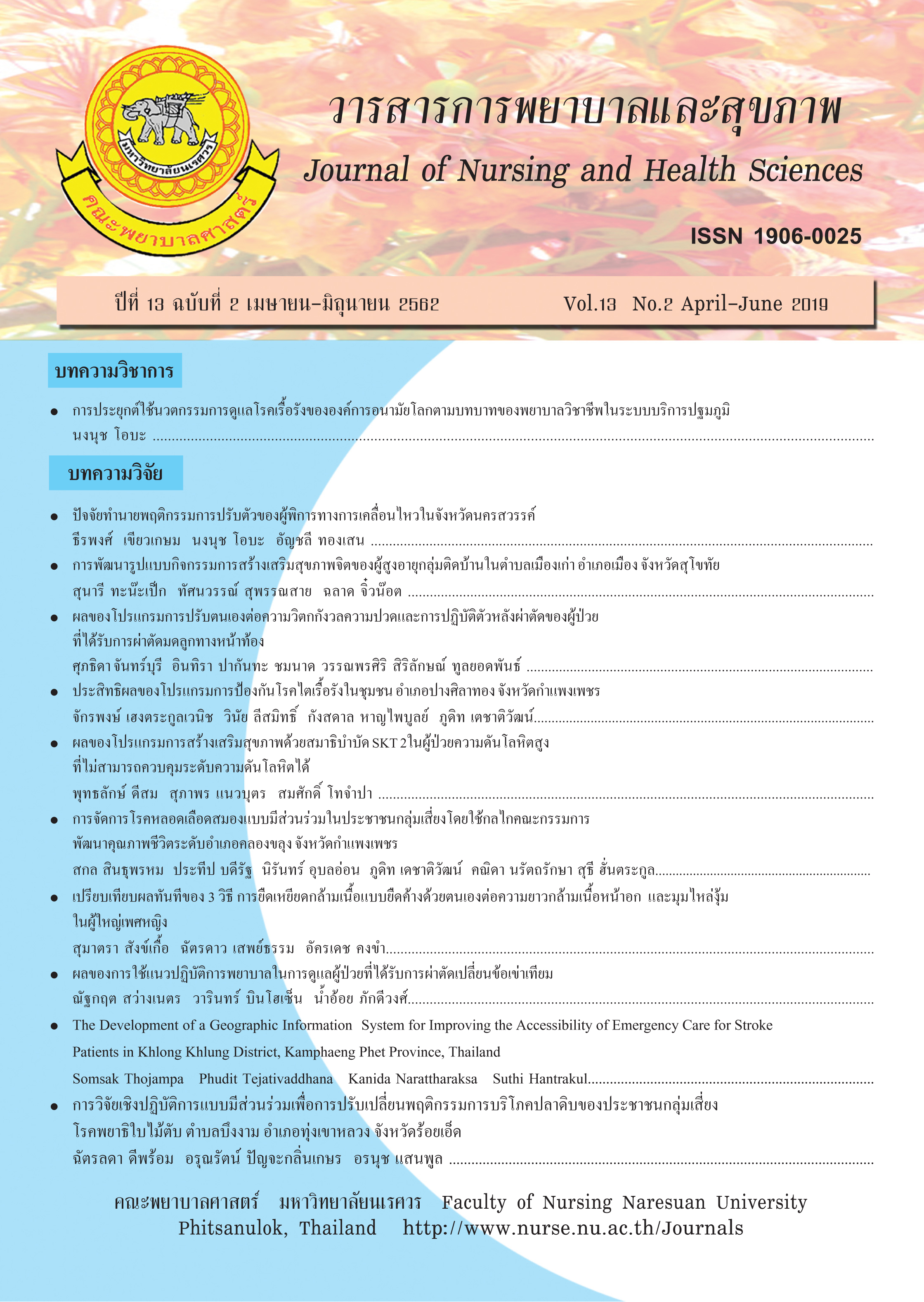The Effectiveness of Community Chronic Kidney Disease Prevention Program, Pangsilathong District, KamphaengPhet Province
Main Article Content
Abstract
This quasi-experimental research aimed at studying the effectiveness of a chronic kidney disease prevention program in a district promotion hospital and in a community, provided by a multidisciplinary team and supported by the district quality of life development committee. The study's population was 936 patients of stage 3 and 4 chronic kidney disease inPangsilathong District, KamphaengPhet Province. Thesamples were 77 patients that were divided into two groups including the experimental group of 47 chronic kidney disease patients of Thakhuendistrict promotion hospital and the control group of 30 chronic kidney disease patients of Nonglomdistrict promotion hospital. The study period was 6 months between May to October 2018. The experimental group was trained and received home visits provided by the multidisciplinary team while the control group received their regular services. The instrument used for data collection were composed ofa questionnaire of general information and clinical data, knowledge testing sheet and behavior assessment form. The statistics used for data analysis were percentage, mean, standard deviation and paired t-test. The results of the study found that after finishing the research, both ofthe experimental and control groups had their mean serum creatinine increased and mean glomerular infiltration rate decreased insignificantly (p > .01). However, the experimental group had the narrower of change of the mean serum creatinine and mean glomerularin filtration rate than that of the control group. Both of the experimental and control groups had their mean knowledge increased significantly (p < .01). The experimental group had their mean behavior for chronic kidney disease prevention improved significantly (p < .01), but the control group had their mean behavior improve dinsignificantly (p < .01). From the study, it pointed out that training and home visitsin a short period could not delay the progress of the decline of renal functions significantly. But theycould increase the levels of both knowledge and behavior for chronic kidney prevention.
Article Details
References
Bhumirajanagarindra Kidney Institute. (2017). Our
kidney, we must know,how to eat faraway from
the dialysis machine for chronic kidney disease
patients predialysis period (3rd ed.). Bangkok:
Bhumirajanagarindra Kidney Institube. [In Thai].
Dell,R.B., Holleran, S., &Ramakrishnan, R. (2002).
Sample size determination. Institute for Labor
atory Animal ResearchJournal, 43(4), 207-213.
Department of Disease Control. (2016). Operating manual
for operations to reduce chronic kidney disease
indiabetic mellitus and hypertension. Bangkok:
Department of Disease Control Ministry of Health.
[In Thai].
Donald M., Kahlon B.K., Beanlands H., Straus S.,
Ronksley P., Herrington G., Tong A., …
Hemmelgarn, B. R. (2018). Self-management
interventions for adults with chronic kidney
disease: a scoping review. British Medical
Journal Open, 8(3), 1-21.
Ingsathit, A., Thakkinstian, A., Chaiprasert, A.,
Sangthawan, P., Gojaseni, P., Kiattisunthorn,
K., …Thai-SEEK Grp. (2010). Prevalence and
risk factors of chronic kidney disease in the Thai
adult population: Thai SEEK study. Nephrology
Dialysis Transplantation, 25(5), 1567-1575. https:/
/doi.org/10.1093/ndt/gfp669
Jiamjariyaporn, T., Banchuin, C., Vipattawat, K.,
Kanchanakorn, S., Saetie, A., Teerapornlertratt,
T., …Sitprija, V. (2014). Effectiveness of integrated
care on delaying chronic kidney disease
progression in rural communities of Thailand
(ESCORT study): Rationale and design of the
study. BMC Nephrology,15(1), 2-7. https://doi.
org/10.1186/1471-2369-15-99
Kidney Disease Association of Thailand.(2016). Thailand
renal replacement therapy year2014.Bangkok:
Kidney Disease Association of Thailand. [In
Thai].
Kidney Disease Association of Thailand.(2013). How
do kidney not fail.Bangkok:Srimeung Printing.
[In Thai].
Lee, S.J., &Chung, C.W. (2014).Health behaviors and
risk factors associated with chronic kidney
disease in Korean patients with diabetes: The
fourth Korean National Health and nutritional
examination survey. Asian Nursing Research,8(1),
-14. https://doi.org/10.1016/j.anr.2013.11.001
Ministry of Health.(2018). Report according to the
ministry indicators 2561:KPI CKD 2.3 delay kidney
deterioration 2561.Retrivedfromhttp://dmhc.dmh.
go.th/ hdc/reports/page_kpi.php?flag_kpi_
level=1&flag_ kpi_year=2018. [In Thai].
National Health Security Office (2016).Fund management
guide:National Health Security2016 manage
patients statements chronic kidney disease.
Bangkok:National Health Security Office.
[In Thai].
Parker, R.M., Baker, D.W., Williams, M.V.,&Nurss,
J.R. (1995).The test of functional health literacy
in adults: a new instrument for measuring
patient’s literacy skills. Journal of Internal
Medicine,10(10), 537-541.
Phuengphasook,S., Wanitkun, N., Towsakulkao, T.,
&Utriyaprasit, K. (2017). Health literacy, health
education outcomes and social influence, and
their relationships with type-2 diabetes and/
or hypertension patients’ clinical outcomes.
Thai Journal of Nursing Council, 32(2), 111-125.
[In Thai].
Polit, D. F., & Beck, C. T. (2006). The content validity
index: Are you sure you know whats being
reported? critique and recommendations. Research
in Nursing and Health 29(5), 489-497
Qobadi, M.,Besharat,M.A.,Rostami, R., &Rahiminezhad,
A. (2015).Health literacy and medical adherence
inhemodialysispatients: The mediating role of
disease-specificknowledge. Thrita, 4(1), 1-6.
Shi, J., Mo, X., &Sun, Z. (2012).Content validity index in
scale development.Journal of Central South
University. Medical Sciences,37(2),152-155.
Washington,T., Zimmerman,S., & Browne, T. (2016).
Factors associated with chronic kidney disease
self-management.Social Work in Public Health,
(2), 58-69.
Yaghmale, F. (2003).Content validity and its estimation.
Journal of Medical Education,3(1), 25-27.


